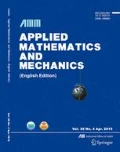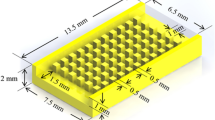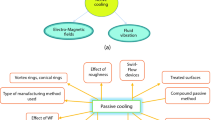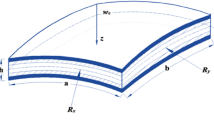Abstract
With the stability analysis of hyperbolic cooling tower shells with ring-stiffeners, our paper proposes the linear pre-buckling consistent theory. The numerical result shows that this linear analysis method is very effective and practical in engineering, for its precision of computation is up to the level of the nonlinear analysis when it is used for the study of critical loads of the hyperbolic cooling tower which is mainly governed by wind pressure and for the study of the effect of some other factors concerned in design on the buckling of shells. Based on that, we have obtained a series of conclusions which will greatly benefits the engineering design when discussing the effect on the critical wind loading of the shell which is caused by the following factors such as the position of rings, the number of rings and the dead weight.
Similar content being viewed by others
References
Der, T.J. and R. Fidler, A model study of the buckling behavior of hyperbolic shells,Proceedings of Institution of Civil Engineerings,41, London, England, Sept. (1968), 105–118.
Chan, A. S. L., and A. Firmin, The analysis of cooling tower by the finite element method,The Aeronautical Journal ofthe Royal Aeronautical Society, Part 1: Small displacements,74, 10 (1970), 825–835; part 2: Large displacements,74, 12 (1970), 971–982.
Yeh, C.H., and W. Y. J. Shieh, Stability and dynamic analysis of cooling tower,Journal of the Power Division, ASCE,99, po2, Nov. (1973), 339–347.
Cole, P. P., et al., Buckling of cooling-tower shell,J. Struct. Div., ASCE,101, ST6, June. (1975), State of the art, 1185–1203; Bifurcation results, 1205–1222.
Veronda, D. R., and V. I. Weingaten, Stability of hyperboloidal shells: An experimental and analytical investigation,USCCE009, School of Engineering, University of Southern California, LosAngeles, Calif., Mar. (1973).
Mungan, I., Buckling stress state of hyperbolical shells,J. Struct. Div.,102, ST10, Oct. (1976), 2005–2020.
Mungan, I., Buckling stresses of stiffened hyperboloidal shells,J. Struct. Div.,105, ST8, Aug. (1979), 1589–1604.
Eckstein, U., et al., Non-linear elastic stability of cooling tower shells,Natural Draught Cooling Towers. IASS-RUB (1984), 333–347.
Abel, J.F., et al., Comparison of complete and simplified elastic buckling analysis for cooling tower shells.Eng. Struct.,8, Jan. (1986), 25–28.
Chien, W.Z.,Variational Methods and Finite Element Methods, Academic Press (1980). (in Chinese)
Bushnell, D., Computerized analysis of shell-governing equations,Computer and Structure,18, 1 (1984), 471–536.
Li Long-yuan, and Loo Wen-da, Analysis of free vibration and response to turbulent wind of hyperbolic cooling towers by ring-stiffeners,Proc. of the Int. Symp.on Membrane Structures and Space Frames, JAMAP, Sept. (1986).
Gu Hao-zhong, Buckling of cooling lower shell with ring-stiffeners, The Thesis of M.D.of Shanghai University of Technology, Jan. (1987). (in Chinese)
Abel, J.F., et al., Buckling of cooling tower,J. Struct. Div., ASCE, ST10, Oct. (1982), 2162–2174.
Author information
Authors and Affiliations
Rights and permissions
About this article
Cite this article
Wen-da, L., Hao-zhong, G. Buckling of cooling tower shells with ring-stiffeners. Appl Math Mech 10, 583–592 (1989). https://doi.org/10.1007/BF02115790
Received:
Issue Date:
DOI: https://doi.org/10.1007/BF02115790




